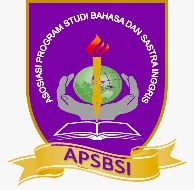GAMBITS FOUND IN THE CONVERSATIONS OF LOOK AHEAD 2 (An English Textbook for Senior High School Students Year XI Published by Erlangga)
Abstract
This is a descriptive qualitative study aiming at finding out what speech acts and gambits found in the conversation models of Look Ahead 2 (an English textbook for senior high school grade XI published by Erlangga). This study was conducted in line with the important roles of gambits in spoken communication.Searle (1969) classified speech acts into five: directives, commissives, representatives, declaratives and expressive with further sub-classified by van Ek (1998) into six functions and 132 sub-functions. These speech act functions have become the basis of English curriculum in Indonesia. The speech acts realizations in utterances are usually hedged by gambits or discourse markers aiming at downgrading, upgrading, intensifying or avoiding a Face Threatening Act. The data were collected from the textbook Look Ahead 2 written by Th. M. Sudarwati and Eudia Grace. The study was focused only on five speech acts: asking for an opinion, giving opinion, agreeing to an opinion, disagreeing to an opinion, and giving suggestion/advice. Therefore, the data taken were only the sentences which indicate those five speech acts.16 conversations were taken as the data. There were 38 clauses belonging to 11 speech act functions specified for XI grade students. The speech acts found were: asking for an opinion, giving opinion, expressing satisfaction, dissatisfaction, giving suggestion, warning, expressing relief, pain, sorrow, anger, and annoyance. There were 34 gambits found in five speech acts: four gambits were found in asking for an opinion, six in giving opinion, five in agreeing to an opinion, ten in disagreeing to an opinion, nine in giving suggestion/advice. Of the five speech acts understudy, there were three types of gambits namely opening, linking, and responding gambits. There were nine gambits belong to opening gambit, three gambits belong to linking gambit, and 22 data for responding gambit.The finding indicated that among 14 speech acts required by the curriculum, 11 speech acts were found but the other three were not. They are expressing pleasure, expressing love and expressing embarrassment. The gambits found in five specific speech acts were used appropriately based on both Keller’s and Dörnyei’s classifications. Among three types of gambits, opening gambit was the most frequently used (52.9%). Responding gambit was the second frequently used (38.2%), and the least frequently used gambit was the linking gambit (8.8%).References
Brown, H. Douglas. 2004. Language Assessment. USA: Longman.
Celce-Murcia, Marianne and Elite Olshtain. 2000. Discourse and Context in Language Teaching. Cambridge: Cambridge University Press.
Cook, Guy. 1989. Discourse. London: Oxford University Press.
Coulthard, Malcolm. 1977. An Introduction to Discourse Analysis. London: Longman.
Cunningsworth, A. 1995. Choosing Your Coursebook. Great Britain: The Bath Press.
D?rnyei, Zoltan and Sarah Thurrell. 1992. Conversation and Dialogues in Action. UK:Prentice Hall International Ltd.
Eggins, Suzanne and Diana Slade. 1997. Analyzing Casual Conversation. London and Washington: Casell.
Elizabeth, M. M. Ed. 2003. Painless Speaking. New York: Barrons Educational Serties, Inc.
Hartoyo. 2011. Linguistic and Educational Research (Course Outline and Course Material).Semarang: Unnes press.
Halliday, M.A.K. 1994. Spoken and Written Language. Victoria: Deakin University Press.
Hatch, Evelyn. 1992. Discourse and Language Education. Cambridge: Cambridge University Press.
Hornby, A.S. 1995. Oxford Advanced Learners Dictionary. Oxford: Oxford University Press.
Hughes, Rebecca. 2002. Teaching and Researching Speaking. United Kingdom: Pearson Education Limited.
van Ek, J.A. and J.L.M. Trim. 1998. Threshold 1990. United Kingdom: Cambridge University Press.
Jones, Leo. 1993. Functions of English (Teacher's Book). Cambridge: Cambridge University Press.
Joyce, Helen d Silva. Ed. 2000. Teachers Voices 6: Teaching Casual Conversation. Sydney: Mcquire University.
Keller, Eric and Sylvia T. Warner. 1988. Conversation Gambits - Real English Conversation Practices. Ottawa: Language Teaching Publication.
Kurniawan, Lanny and Siti N. Artiningsih. 2008. English Today 2. Jakarta: Quadra.
Lee, Beryl C. et al. Discourse Marker Teaching in College Conversation Classrooms: Focus on well, you know, I mean ?? ? ? ? ? ? ? ?. China: CEPS, 2004. pp. 177-199
Longman. 1992. Dictionary of English Language Culture. New York: Longman Group Ltd.
Matei, M?d?lina. 2010. Discourse Markers as Functional Elements. Bulletin of the Transilvania University of Brasov . Vol. 3 (52). Series IV: Philology and Cultural Studies.
Mujiyanto,Yan. 2011. Petunjuk Penulisan Skripsi. Semarang: Semarang State University Press.
Mukhoyyaroh, Siti. 2010. A Final Project: An Analysis of Conversation Gambits Produced by the Participants (Broadcaster and Caller) of English Interactive Program Pro 2 English Time on RRI Semarang. Semarang: Unpublished.
Nunan, D. 2003. Practical English Language Teaching. New York: The McGraw-Hill Companies.
Nurmawati, Dwi. 2008. A Final Project: The Speech Functions Found on Ten Conversational Texts Displayed 0n new snapshot pre-intermediate Published by Longman. Semarang: Unpublished.
Richards, Jack C. and Richards W. Schmidt. 1983. Language and Communication. London: Longman.
Schiffrin, Deborah. 1987. Discourse Markers. Cambridge: Cambridge University Press.
________________, 2001. Discourse markers: language, meaning and context. In: Schiffrin, D., Tannen, D., Hamilton, H.E. (Eds.), The Handbook of Discourse Analysis. Blackwell, Malden, MA, pp. 5475.
Sudarwati. Th.M. and E. Grace. 2007. Look Ahead: An English Course for Senior High School Students Year XI. Jakarta: Erlangga.
Tarigan, Drs. Djago and Prof. H.G. Tarigan. 1986. Telaah Buku Teks SMTA. Jakarta: Departemen Pendidikan dan Kebudayaan. Universitas Terbuka.


_.jpg)
_.jpg)




